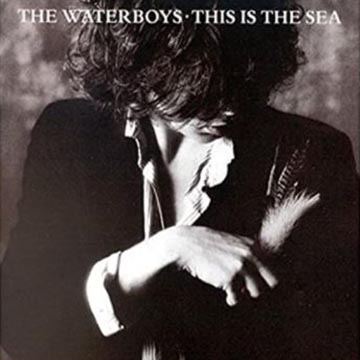This Is The Sea
by Peter Grainger
"This Is The Sea" was the third album from British folk-prog-rockers The Waterboys, released in October 1985. Undisputed leader Mike Scott wrote a track on the previous album called "The Big Music"-- and that just about sums up a sound, style and
trend for British rock in the mid-80s-- think soaring, anthemic barn-burners like Simple Minds, Big Country and U2-- all fellow and competing torch bearers. Big songs, big voices, big guitars, big drums, big production. Big, big, big! This big album
included one of The Waterboys biggest songs of them all: "The Whole of the Moon".
The aforementioned song gave The Waterboys their biggest single hit so far. It really is such a great, inspired and inspiring song, yet it began as a question posed by Mike Scott’s girlfriend at the time, when she asked, “So is it easy to write a
song?” Rising to the challenge, as they walked along NYC’s Lexington Avenue, Scott wanting to impress his gal, looked around for something to light the song-writing spark. He didn’t need to look any further than skyward, where a full moon stared back.
Scott immediately wrote the title down on an envelope. From that, the key refrain: “I saw the crescent, you saw the whole of the moon…” popped into his head. Later that night at his hotel, Scott began working on a chord pattern on his acoustic guitar,
while a melody began to emerge from the depths of the night. Some of the lyrics came right then and there, but not all.
But Scott skyrockets it even higher with the emotional crescendo: “You came like a comet, blazing your trail, too high, too far, too soon, you saw the whole of the moon.” One production touch that sears the song shut, is one beat after he sings,
“You came like a comet…” comes a burst of fireworks—a sample borrowed from an old BBC sound effects record. Breath-takingly brilliant.
Scott has admitted he drew direct inspiration for this album from the novel “Winter’s Tale” by American Mark Helprin; he says Helprin added fuel to his creative fire, and although he refutes that “The Whole of the Moon” was about the lovers in the novel,
Scott demoed another song released many years later—called “Beverly Penn”; she and her lover Peter Lake, are the main characters in the book.
In his autobiography, “Adventures Of A Waterboy”, Scott recalls the pool of new songs was 35 to 40 deep; some still contained borrowed lines and phrases from other writers, like Lennon & McCartney, William Butler Yeats and James Joyce— a habit that lingered
from his song-writing infancy.
Musically, Scott cites The Velvet Underground, Van Morrison and minimalist ‘systems’ composer Steve Reich as main influencers for “This Is The Sea”. From the Velvets, he grasped that passionate, imperfect playing can trump technical perfection— sometimes
two-chords is enough. From Van The Man, especially “Astral Weeks”, he absorbed atmosphere, rat-tat-tat rhythms, the subtlety of string bass and that string arrangements can be light and luminous, even recording the Belfast Cowboy’s classic “Sweet Thing” during
the sessions, which were co-produced by Morrison’s engineer Mick Glossop. From Reich, he learned a new musical language, a disciplined form, where long sustaining chords and repetition rule.
It is Reich’s influence that is the most striking aspect of these songs. Where Scott had favoured guitars on earlier albums, this one relies on simple, repetitive piano chords that shift slightly as songs builds. “Spirit”, “Trumpets” and “Old England” are perfect
examples of this. In the 2004 Expanded Edition, there are several instrumentals like “High, Far, Soon” and “Even The Trees Are Dancing” that are overtly Reichian in texture and tone. Scott was ably assisted by Karl Wallinger too, who contributed so many great piano,
synth and other keyboard parts, giving the album a rich, sumptuous feel.
The Reichian influence found its way into two key tracks, “The Pan Within” and the title track, where the multi-tracked stacks of piano are replaced by acoustic 12-string guitars. Both “This Is The Sea” and “The Pan Within” (with Waterboy mainstay Steve Wickham
on fiddle for the first time) shimmer in a sea of 12-strings, cascading over each other, into big baths of ringing warmth, pointing the way to The Waterboys next artistic turn, the Celtic folk-rock of “Fisherman’s Blues”. But that, as they say, is another story, for another time.

This Is The Sea
Artist: The Waterboys
Album: This Is The Sea
Release Date: October 1985
Label: Chrysalis